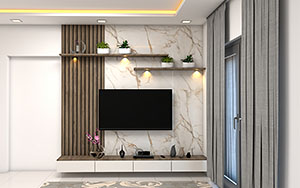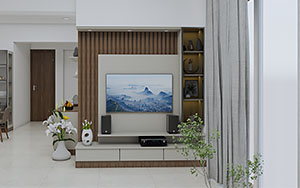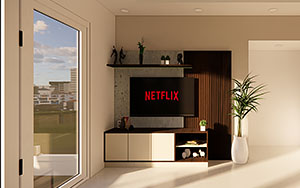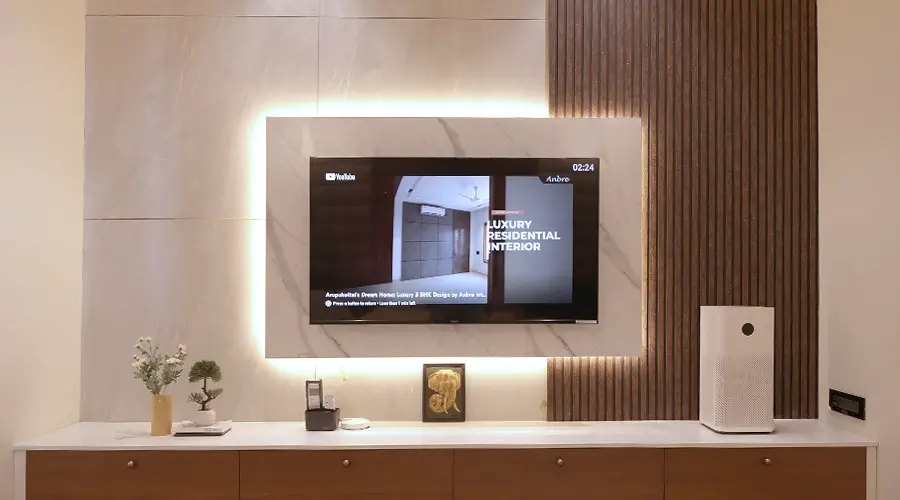TV Unit Design
Modern TV Unit Design Ideas for the Main Hall and Living Room by Anbre Interiors
A well-designed TV unit can elevate the aesthetic of your living room or main hall, creating a focal point while maximizing functionality. Whether you’re looking for sleek, modern designs or space-saving solutions, a thoughtfully designed TV unit can enhance the overall look of your space. Let’s explore various styles and options to suit your home’s design needs.
Latest Trending TV cabinet designs from Anbre
The latest TV unit designs for the living room focus on multifunctionality. They often incorporate space-saving features like pull-out drawers, hidden storage compartments, and mountable shelves. Glass doors, mirrors, and metallic accents are trending, giving the unit a modern, sophisticated look. Transform your hall with a modern TV unit to enhance its style and functionality.



Rental friendly TV units
The wooden rafters are timeless feature to add to your TV units

main hall modern tv unit design
A contemporary modern TV unit design can be the centerpiece of your living room, transforming it into the heart of your home.

Glassy Marble Finish TV Unit
Glassy Marble Finish TV Unit: A modern floating design with hidden wires and LED lights, combining wood and metal for a stylish balance.
tv unit design for hall 2024 - latest images

tv unit design for hall

luxury tv unit design

latest tv unit design
Do you have a specific design style in mind?

Top TV Unit design

tv unit furniture design

wooden tv unit design
FAQs About Luxury Tv Unit Design Ideas
A TV unit in the living room has many benefits beyond just holding the television. First, it acts as a focal point, anchoring the room’s design. It creates a central spot for family and guests to gather.
A well-designed TV unit can make the living room look better. It helps blend the television into the overall décor instead of letting it take over the space.
Functionality is another important benefit. TV units usually have different storage options, like shelves, drawers, and cabinets. These spaces can hold multimedia devices, DVDs, remote controls, and other accessories. This keeps the living room organized and free of clutter. Some units also have cable management systems to hide and organize wires, making the room look tidy.
TV units can also improve viewing angles and comfort. By placing the TV at the right height and angle, they ensure a good viewing experience.
Many units have adjustable features, so you can change the setup based on your seating and preferences. They often provide space for sound systems, gaming consoles, and other entertainment equipment, enhancing your overall experience
Choosing the right size TV unit is important for your living room. You want it to fit well without taking over the space.
Start by measuring the wall where you will place the unit. The TV unit should match this space and leave some room on each side for balance.
It should be a bit wider than your TV. This gives a stable base and space for items like speakers or decorations.
Think about the height of the unit, too. The center of the TV screen should be at eye level when you sit down. This is usually about 42-48 inches from the floor. A unit that is too high or too low can hurt your neck and make watching TV less enjoyable.
In a large living room, a taller unit can be a great focal point. In smaller rooms, a lower unit can help keep the space open.
The depth of the unit is also important. Make sure it can hold your TV’s base or wall mount and has room for other devices.
Finally, consider the style and material of the unit. It should match your current décor.
A unit that is too big can make the room feel cramped. A unit that is too small may look out of place and not provide enough storage.
Contemporary: These units feature sleek, minimalist designs with clean lines and often incorporate modern materials like glass, metal, and high-gloss finishes. They are ideal for modern homes that prioritize simplicity and functionality.
Traditional: Traditional TV units are often made from wood and feature intricate details, moldings, and classic hardware. They suit homes with a more classic or vintage décor, offering a warm and elegant look.
Rustic: Rustic TV units embrace natural materials and a handcrafted look. They often feature distressed wood, metal accents, and a more rugged appearance, perfect for homes with a farmhouse or country-style aesthetic.
Industrial: Inspired by urban lofts and warehouse spaces, industrial TV units combine raw materials like metal and reclaimed wood. They have a sturdy, no-nonsense look that pairs well with exposed brick walls and utilitarian furnishings.
Scandinavian: These units are characterized by their simplicity, functionality, and use of natural materials. They often feature light woods, clean lines, and a minimalist approach, making them perfect for airy, modern spaces.
Mid-Century Modern: With their clean lines, gentle curves, and functional form, mid-century modern TV units bring a touch of retro style to any room. They often feature tapered legs, warm wood tones, and a balanced mix of open and closed storage.
Integrating a TV unit into a small living room requires careful planning to ensure it adds functionality without overwhelming the space. Start by choosing a compact unit that provides sufficient storage without taking up too much floor space. Wall-mounted TV units are an excellent option for small rooms as they free up floor space and create a streamlined look. Floating shelves or units with a slim profile can also help maintain an open and airy feel.
Utilize vertical space by selecting units that offer ample storage through tall cabinets or stacked shelves. This approach maximizes storage without expanding the unit’s footprint. Consider units with built-in cable management systems to keep wires organized and out of sight, contributing to a cleaner, more organized appearance.
Multipurpose furniture can be highly beneficial in small living rooms. Look for TV units that double as bookshelves, display cases, or even desks. This versatility allows you to make the most of your space and reduces the need for additional furniture pieces. Additionally, choosing a unit with a light color or reflective surfaces can help make the room feel larger and more open.
Finally, consider the room’s layout and seating arrangement. Placing the TV unit against a central wall and arranging seating around it can create a focal point and enhance the sense of space. Avoid blocking pathways and ensure there is enough room for easy movement. With thoughtful design and careful selection, a TV unit can enhance both the functionality and aesthetic of a small living room.
TV units are made from a variety of materials, each contributing to the unit’s overall design, durability, and maintenance requirements. Common materials include:
Wood: Wood is a popular choice for its durability, versatility, and timeless appeal. Solid wood units, such as those made from oak, walnut, or teak, offer a classic and sturdy look. Engineered woods like MDF or plywood are often used in more affordable units and can be finished with veneers to mimic the appearance of solid wood. Wood units can range from traditional to modern designs, depending on the finish and construction.
Metal: Metal TV units, often made from steel or aluminum, are durable and can add a modern or industrial touch to the living room. Metal is often used for frames, legs, and hardware, providing a sleek and contemporary look. It is also resistant to damage and easy to maintain.
Glass: Glass elements, such as shelves or cabinet doors, can give TV units a light and airy feel. Tempered glass is durable and safe for use in furniture. Glass units often feature minimalist designs and can help make a room feel more spacious. However, they require regular cleaning to keep them looking their best.
Laminate and Veneer: These materials are often used to achieve the look of wood or other finishes at a lower cost. Laminate is easy to clean and resistant to scratches, making it a practical choice for households with children or pets. Veneers provide a wood-like appearance and are applied over MDF or plywood, combining affordability with a high-quality look.
Plastic and Acrylic: These materials are lightweight and can be molded into various shapes and designs. They are often used in modern and contemporary TV units, offering a range of colors and finishes. While not as durable as wood or metal, they can be a stylish and affordable option.
The choice of material affects the unit’s durability, maintenance, and overall aesthetic. When selecting a TV unit, consider the existing décor, the level of use, and maintenance requirements to ensure the material suits your needs and style.
Managing cables and wires is crucial for maintaining a clean and organized look in your TV unit. Many TV units come with built-in cable management systems, including cutouts, channels, and clips to route and conceal wires. Here are some tips for effectively hiding cables:
Cable Management Systems: Look for TV units with built-in cable management features. These may include holes or channels at the back of the unit to route wires through, keeping them out of sight. Some units also have clips or straps to bundle and secure cables.
Cable Covers and Raceways: Use adhesive cable covers or raceways to route wires along the wall or baseboards. These covers can be painted to match the wall color, making them less noticeable. They provide a tidy way to hide wires running from the TV to the power outlet or other devices.
Cord Concealers: Velcro straps, cable ties, or cord concealers can help bundle and organize cables, preventing them from tangling and becoming unsightly. Use these to group cables together and secure them to the back of the unit or along furniture legs.
Furniture Placement: Position the TV unit close to power outlets and cable inputs to minimize the length of exposed wires. Use the unit’s storage compartments to house devices and route cables behind or through the furniture to keep them hidden.
Wireless Devices: Opt for wireless versions of devices when possible. Wireless speakers, streaming devices, and other peripherals reduce the number of cables needed, simplifying the setup and maintaining a cleaner look.
By implementing these strategies, you can effectively manage and conceal cables, enhancing the overall appearance of your TV unit and living room.
Incorporating a TV unit into an open-plan living space requires careful consideration to ensure it enhances both the functionality and aesthetics of the room. Here are some tips:
Create a Focal Point: Position the TV unit in a way that creates a focal point within the open-plan area. Place it against a feature wall or as part of a room divider to visually define the TV area and integrate it into the space.
Use a Room Divider: Consider using a TV unit as a room divider. Units with open shelving or cabinetry can act as a partition, helping to separate different zones in the open-plan layout while providing additional storage and display options.
Incorporate Multi-functional Furniture: Opt for TV units that offer additional functionality, such as built-in storage, display cabinets, or workstations. This versatility allows you to maximize the use of space and reduce the need for additional furniture.
Match the Décor: Ensure the TV unit complements the overall décor of the open-plan space. Choose materials, colors, and finishes that harmonize with the room’s existing design elements to create a cohesive look.
Consider Viewing Angles: Ensure the TV unit is positioned for optimal viewing from various areas of the open-plan space. Use swivel or tilting mounts if necessary to adjust the TV’s angle and provide comfortable viewing for all seating areas.
Use Lighting Effectively: Incorporate lighting around the TV unit to enhance its appearance and create a visually appealing environment. Consider using LED strips, pendant lights, or wall sconces to highlight the unit and contribute to the room’s ambiance.
By thoughtfully integrating the TV unit into an open-plan living space, you can enhance both the functionality and visual appeal of the room, creating a harmonious and inviting environment.
Styling a TV unit involves arranging the unit and its accessories to create a visually appealing and functional setup. Here are some tips for styling your TV unit:
Use Decorative Accessories: Add decorative items such as vases, candles, or photo frames to the TV unit’s shelves or surface. Choose accessories that complement the room’s décor and add visual interest without overcrowding the space.
Incorporate Greenery: Include plants or succulents on or around the TV unit to bring a touch of nature into the room. Opt for low-maintenance plants that thrive indoors and fit well with the unit’s design.
Add Art or Wall Décor: Hang artwork, mirrors, or decorative panels above or around the TV unit to create a focal point and enhance the room’s design. Ensure the artwork complements the unit and the overall style of the room.
Create Balance: Arrange items on the TV unit in a balanced manner. Use a mix of heights, textures, and colors to create visual interest. Avoid cluttering the unit with too many items, as this can detract from the overall look.
Utilize Storage Effectively: Keep frequently used items and media devices organized and accessible. Use baskets, trays, or decorative boxes to store remote controls, DVDs, and other accessories, maintaining a clean and tidy appearance.
Consider Lighting: Use LED strips or accent lights on or around the TV unit to highlight the area and create a warm, inviting ambiance. Proper lighting can enhance the unit’s design and make it a focal point in the room.
By following these styling tips, you can create a visually appealing and functional TV unit setup that enhances the overall décor of your living space.
Proper maintenance and cleaning are essential to keep your TV unit in good condition and ensure it remains a functional and attractive part of your living space. Here are some tips for maintaining and cleaning your TV unit:
Dust Regularly: Dust the TV unit frequently to prevent buildup that can affect its appearance and functionality. Use a soft, dry microfiber cloth to gently wipe down surfaces, shelves, and other components. For hard-to-reach areas, use a small, soft brush or a duster.
Clean with Appropriate Products: Use cleaning products that are suitable for the materials used in your TV unit. For wood units, use a wood cleaner or polish, and avoid abrasive cleaners that can damage the finish. For glass surfaces, use a glass cleaner and a lint-free cloth to avoid streaks.
Avoid Excessive Moisture: When cleaning, avoid using excessive moisture, as it can damage the materials or cause warping. Wipe up spills and stains promptly with a dry or lightly dampened cloth to prevent any potential damage.
Check for Loose Parts: Periodically check the TV unit for any loose or damaged parts. Tighten screws and bolts as needed to ensure stability and prevent wobbling. Address any issues promptly to avoid further damage.
Organize Cables: Regularly check and organize cables and wires to prevent tangling and damage. Use cable management solutions to keep wires neatly arranged and out of sight.
Protect from Direct Sunlight: Avoid placing the TV unit in direct sunlight, as prolonged exposure can cause fading or damage to the materials. Use window coverings or reposition the unit if necessary to protect it from UV rays.
By following these maintenance and cleaning tips, you can keep your TV unit looking and functioning its best for years to come.
Modern TV units often come with a range of innovative features designed to enhance functionality and convenience. Here are some features to consider when selecting a contemporary TV unit:
Built-in Cable Management: Look for TV units with integrated cable management systems, such as cutouts, channels, and clips. These features help keep wires organized and hidden, maintaining a clean and clutter-free appearance.
Adjustable Shelving: TV units with adjustable or removable shelves offer flexibility in organizing and accommodating different-sized devices. This feature allows you to customize the unit based on your storage needs and preferences.
Integrated Lighting: Some modern TV units include built-in LED lighting or backlighting to create a visually appealing effect and enhance the ambiance of the room. Lighting can also be used to highlight the TV unit or provide additional illumination.
Smart Features: Consider TV units with smart features such as wireless charging pads, Bluetooth speakers, or built-in USB ports. These features add convenience and functionality, allowing you to charge devices, play music, or connect additional equipment easily.
Modular Design: Modular TV units offer customizable and expandable options, allowing you to rearrange or add components based on your changing needs. This adaptability is ideal for growing or evolving living spaces.
Hidden Storage: Units with concealed or hidden storage compartments provide a sleek and minimalist look while offering practical storage solutions for items such as remote controls, game consoles, and DVDs.
Multi-functional Design: Some modern TV units combine additional functions, such as built-in fireplaces, display cabinets, or workstations. These versatile designs enhance the functionality of the unit and provide added value to the living space.
By considering these innovative features, you can select a modern TV unit that not only complements your décor but also enhances the functionality and convenience of your living room.
Modern TV Unit Design Ideas for Your Living Room or Main Hall
A well-designed TV unit can be the focal point of your living room or main hall, elevating the space’s aesthetic while providing essential functionality. Whether you prefer sleek, modern designs or space-saving solutions, a thoughtfully chosen TV unit can enhance the overall look of your home.
Key Considerations for Your TV Unit:
- Space: The size and layout of your room will determine the best TV unit design.
- Style: Your TV unit should complement the overall décor of your space.
- Functionality: Consider your storage needs for media devices, books, and other items.
Popular TV Unit Designs:
Minimalist Elegance:
- Clean lines and open shelving: For a modern and uncluttered look.
- Wall-mounted units: Maximize floor space in smaller rooms.
- Neutral colors: Create a timeless and versatile aesthetic.
Functional and Stylish:
- Modular designs: Customize your unit to suit your specific needs.
- Hidden storage: Keep your space organized and clutter-free.
- Integrated lighting: Create a warm and inviting ambiance.
Space-Saving Solutions:
- Corner units: Optimize space in smaller rooms.
- Compact designs: Ideal for limited space.
- Floating shelves: Add storage without taking up floor space.
Additional Tips:
- Consider your entertainment needs: Choose a unit that accommodates your media devices and accessories.
- Pay attention to details: The finish, hardware, and lighting can significantly impact the overall look of your TV unit.
- Personalize your space: Add your own touch with decorative items, books, or artwork.
Choose a TV unit from Anbre Interior that matches your style and needs. This will help you create a functional and attractive centerpiece for your living room or main hall.



